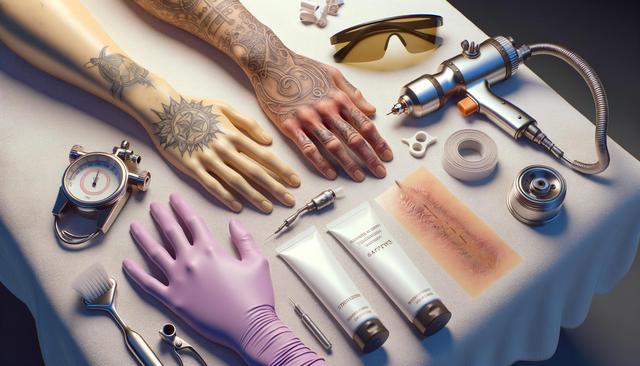The Science Behind How Laser Tattoo Removal Works
Laser tattoo removal is a widely used method that relies on light-based technology to break down ink particles in the skin. Understanding how laser tattoo removal works begins with recognizing how tattoos are embedded into the dermis layer of the skin. When a tattoo is applied, ink particles are too large for the body to eliminate naturally. Laser treatments use concentrated beams of light that penetrate the skin and fragment the ink into smaller particles. These smaller fragments are then absorbed and expelled by the body’s immune system over time. Modern lasers, such as Q-switched or picosecond lasers, offer targeted wavelengths that are selected based on the ink color, ensuring more efficient results with minimal damage to surrounding skin.
Each laser session usually targets specific colors, as different pigments absorb different wavelengths of light. For example, black ink is the easiest to remove because it absorbs all laser wavelengths, while green and blue inks may require more sessions and specialized lasers. This precise approach is a key part of advanced skin treatment technology, which continues to evolve for safer and more effective tattoo removal experiences.
Factors That Influence Tattoo Fading Speed
One of the most common questions people ask is what affects tattoo fading speed. Several variables impact how quickly a tattoo fades during the removal process, and understanding these can help set realistic expectations. Important factors include:
- Ink color and quality: Darker inks fade faster than lighter or multi-colored tattoos.
- Age of the tattoo: Older tattoos are generally easier to remove because the body has already broken down some of the ink naturally.
- Location on the body: Tattoos on areas with better blood circulation (like the chest or arms) tend to fade faster than those on the lower legs or feet.
- Skin type and immune response: Individual healing responses play a significant role in ink breakdown and removal rate.
In addition to these factors, lifestyle choices such as staying hydrated, avoiding smoking, and maintaining a healthy immune system can support the body’s ability to clear ink particles more efficiently. A personalized tattoo removal plan often takes these variables into account to optimize outcomes for each individual.
Recovery After Tattoo Removal Sessions
Recovery after tattoo removal sessions is an essential component of the overall process. While laser treatment is non-invasive, it still causes controlled damage to the skin, which requires time and care to heal properly. After each session, the treated area may be red, swollen, or slightly blistered, similar to a mild sunburn. These side effects are temporary and typically subside within a few days to a week.
Proper aftercare can support healing and reduce the chance of complications. Key steps include:
- Keeping the area clean and covered for the first 24 hours
- Avoiding direct sunlight and applying sunscreen to the treated skin
- Refraining from picking at scabs or blisters
- Following any specific instructions provided by your cosmetic dermatology provider
It’s also important to allow sufficient time between sessions—generally 6 to 8 weeks—to let the skin heal and give the immune system time to eliminate the fragmented ink. Adhering to a proper recovery routine can make a significant difference in overall results and skin health.
Role of Advanced Skin Treatment Technology
Advancements in laser and skin treatment technologies have greatly improved the tattoo removal process. Today’s equipment is more precise, less painful, and more effective at targeting a wide range of ink colors. These innovations are a significant aspect of cosmetic dermatology services, allowing providers to offer safer and more customized treatments.
Some of the most notable technological developments include:
- Picosecond lasers that emit ultra-short pulses, making ink fragmentation more effective
- Adjustable wavelengths to target specific colors
- Cooling systems to reduce discomfort and minimize skin damage during treatment
These tools not only accelerate the removal process but also reduce the number of sessions required. By embracing advanced skin treatment technology, practitioners can design more effective and comfortable procedures tailored to each client’s tattoo characteristics and skin type, contributing to more satisfying outcomes.
The Importance of Personalized Tattoo Removal Plans
No two tattoos or skin types are exactly alike, which is why personalized tattoo removal plans are essential. A tailored approach considers individual factors such as tattoo size, location, color, and the client’s skin characteristics. This customization allows practitioners to adjust laser settings, session intervals, and aftercare recommendations to best suit each person’s needs.
During the initial consultation, cosmetic dermatology services typically perform a skin assessment and review the client’s medical history. From there, a customized roadmap is created, outlining the expected number of sessions, care instructions, and realistic outcomes. Personalized tattoo removal plans help manage expectations and ensure the safest and most effective path to tattoo removal.
Clients are also encouraged to communicate openly during the process. Adjustments can be made based on how the skin responds or if additional concerns arise. The combination of personalized care, professional expertise, and advanced technology provides a comprehensive experience for those undergoing tattoo removal.




Leave a Reply